This review will mainly discuss the new additions to Vue 8 Infinite. What I will try to do is discuss the most important new features of Vue 8. When reviewing a program, deciding which features to discuss is always a hard decisions. There are always those that the company has highlighted, but there are often a lot more that can change how one uses a program and the ultimate effects that can be achieved. This is, also, somewhat subjective depending on how you use the program. I basically use Vue for creating still images that I print as well as put on the web. I will take a number of the new features and describe them under headings consistent with e-on documents. For a complete list of new features and comparisons to older versions, see the links below.
I am adding some links to the beginning of the review to pages I have copied from the e-on website: a comparison Vue 8 Infinite of features and those of Vue 7 and Vue 7.5 and a listing of all Vue 8 features and those new from Vue 7 Infinite.
Real-Time Preview
The first new features I will describe are the new OpenGL options. Vue 8 has added a new OpenGL engine as well as the ability to allocate video board memory to Vue. If the video board does not support the new OpenGL 2.1 (Shader 4 engine), Vue will automatically choose the Fixed Pipeline option. As stated above, Vue 8 now has the option of allocating video board memory to be used in Vue. The default is 128MB and you can add additional memory (depending on the amount of memory of your video card) which you will want to do. If the card doesn't have enough memory on it, Vue 8 will modify how the scene is displayed. We are speaking about Preview Options in the 4 viewports
- OpenGL 2.1 (Shader 4)
- OpenGL (fixed hardware pipeline)
- OpenGL (software)
(This is a definition of the new option from page 440 of the Vue 8 online manual:
"OpenGL 2.1 (shader 4): select this option to enable OpenGL previewing of the scene using this display engine, based on the programmable shader supported by recent graphics cards with GPU’s such as the NVIDIA GeForce 8000 or the ATM HD 3000 and above. When you first start Vue, if your card supports this feature, it will be automatically selected. This setting provides per pixel lighting for diffuse and highlights. It will also enable the shaded billboard feature for EcoSystem previews.")
Below are two screen captures of the Main Preview Window. The one from Vue 8 utilizes the new Shader 4. The one from Vue 7.5 uses OpenGL Hardware acceleration. Shaded billboards are now used, if your video card supports it, to display EcoSystems. This is really useful in visualizing how the scene might look after rendering.
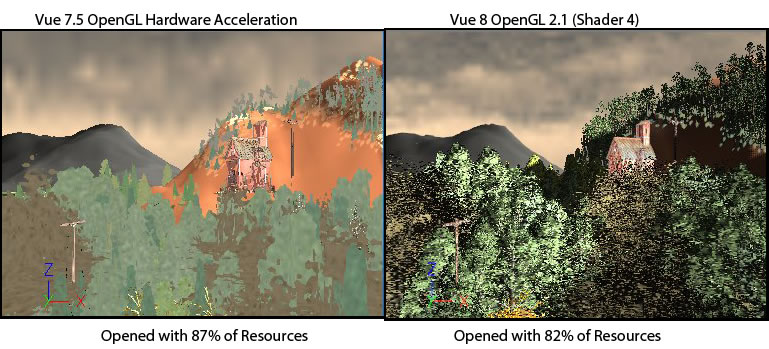
On the 8 gig machine with the video card that had only 256 MB of memory, I first found out that it could not use the new shader and the program switched to the hardware setting. Then, I allocated the whole 256 MB, but it was not enough for the new method Vue uses to previewed the scene so it changed the preview to the older way.
Improved Real-Time Previewing helps the user tremendously to visualize the scene as it progresses. Below are just a few examples of this new function as it relates to EcoSystems and MetaClouds. I love the addition of the OpenGL 2.1 Engine and the improvements in preview shading.
I do a lot of work using MetaClouds over terrains, etc. and being able to see the "puffs of white" visually is marvelous.
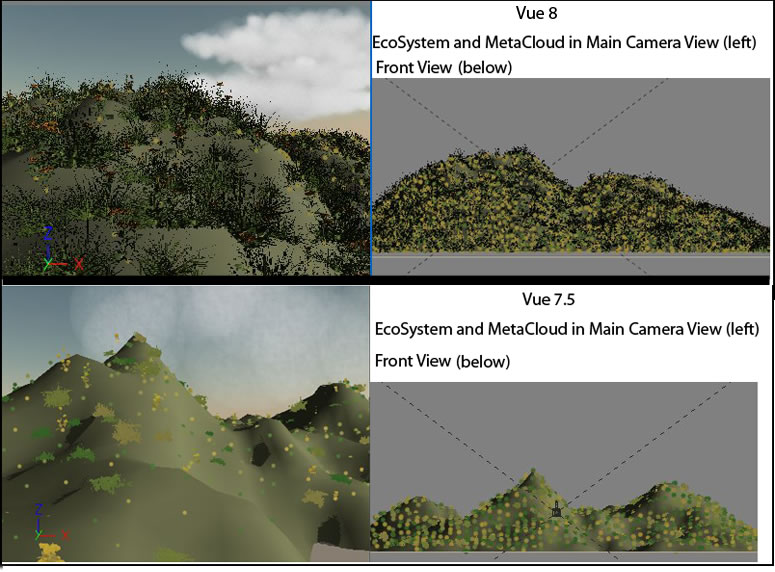
User Interface
Some of the new additions while listed under the User Interface in e-on documentation cross over lines . I will discuss rigging separately.
There is a new feature when you paint on an EcoSystem. In the World Browser, it will show up as a Global EcoSystem under Instances. You can manipulate the position, size, etc. These can be selected and deleted with one click. Notice the position of the rocks in the waterscape image. It was very easy to change their position.
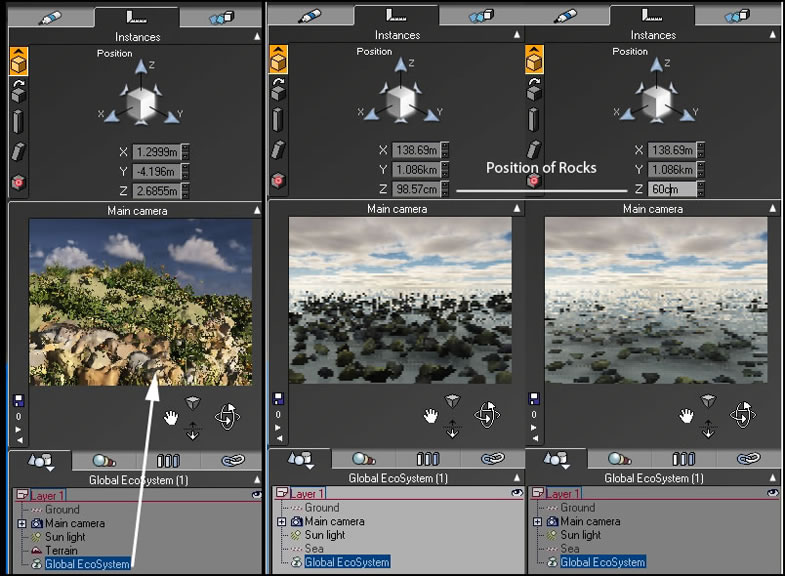
Some other nice new features which just make work easier are the fact that names of Atmospheres appear in the Atmosphere Editor as do the names of edited function in the Function Editor.
The Material Editor has changed some of its face as well and has added functions that are no longer global but can apply to individual materials. An addition that I believe can help control render times, especially if you use Texture Anti-Aliasing. is the TAA that can apply to one material and not have to be applied globally.
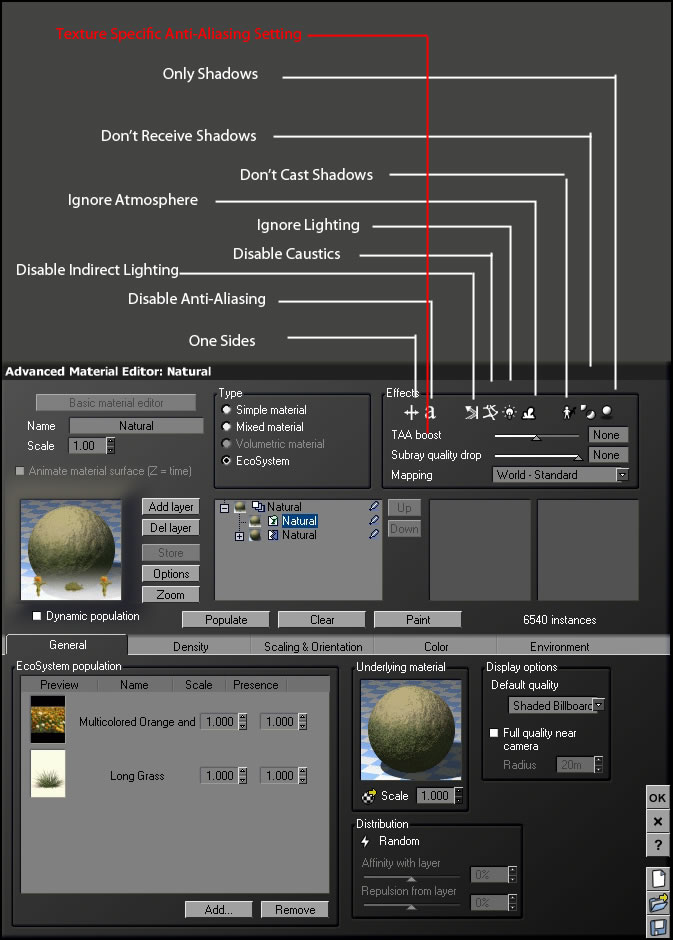
Rendering
Color and Alpha masks can be generated from the Global EcoSystem Instances when using Multi-Pass rendering. Below is a compilation where the long grass was selected and a screen capture of the Alpha channel is shown to the right of the image.
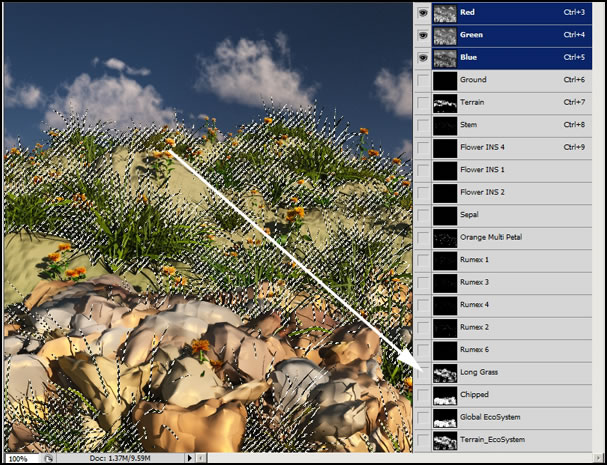
Terrains
Perhaps the most well publicized new aspect of Vue 8 Infinite is Terrain Sculpting. This is a feature we have been waiting for. I love it. Finally, it is easy to get the shape of the terrain that I envisioned.
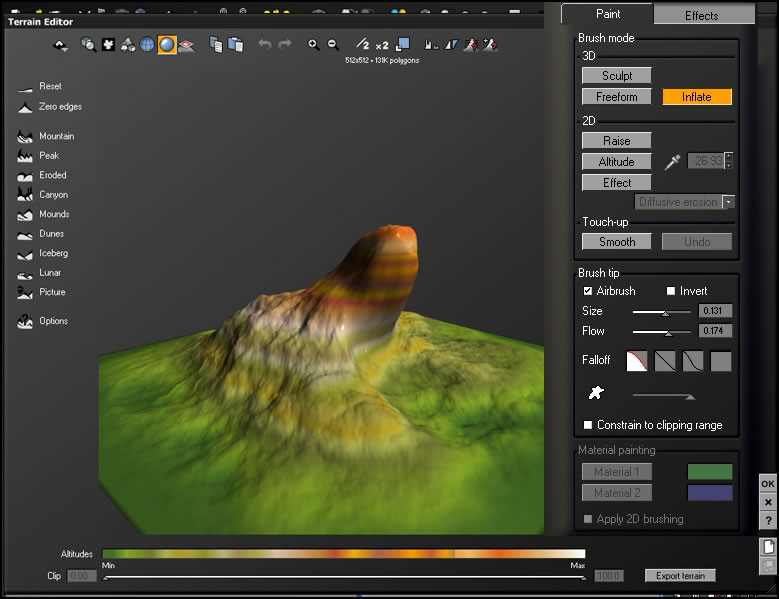
I found that in Vue 8 Infinite, I had better control of the 2d tools than in other versions. Also, you will see that there is no longer a dig feature. It isn't necessary because invert takes its place. I found this a great idea because I can use it with other functions such as inflate.
Below are two terrains, before and after. I rendered them at 640 x 480 using the Final Render setting.
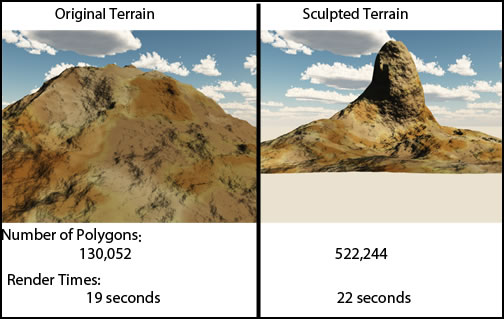
A number of new features have been added to the Terrain Editor. I will list a few:
- Sculpt terrains in all directions
- Sculpt, inflate, free form and smooth brushes
- Create edition "zones" to modify procedural terrains locally
"This [zone] allows you to work with much higher resolution on that area of the terrain with a more
detailed heightmap. There is also less subdivision occurring which speeds processing." Page 220 Vue 8 manual.

- Stratified terrains thanks to the Recursive node and Strata filters
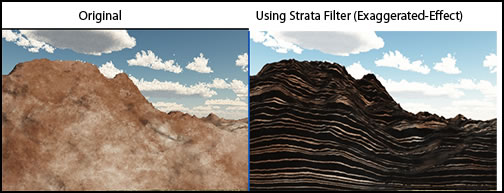
The above right picture was created without any knowledge of how the Strata Filter worked. It is exaggerated intentionally. I had the privilege of reviewing QuadSpinner's tutorial called The Beauty of Strata. He described how to use the Strata filter and the Confined Strata filter contained in the new Recursive node in the Function Editor. After working with it only one morning, I realized the control I could have as well as the infinite results possible toward creating more realistic terrains. Two of my first examples are shown below.
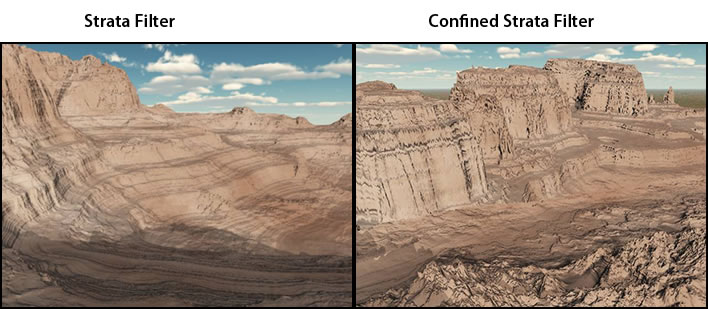
- Edit terrains in context (view entire scene in Terrain Editor)
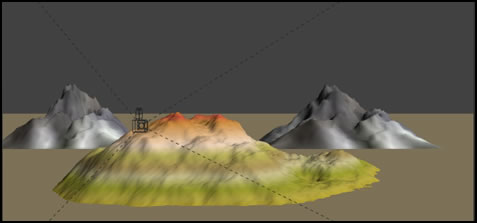
Atmosphere
The new Spectral 3 Atmosphere has increased the ability to create more realistic and dynamic looking clouds as well as to create Godrays more easily. I used two scenes from the Vue Sample scenes to create the following. It is hard to compare differences in small renders.
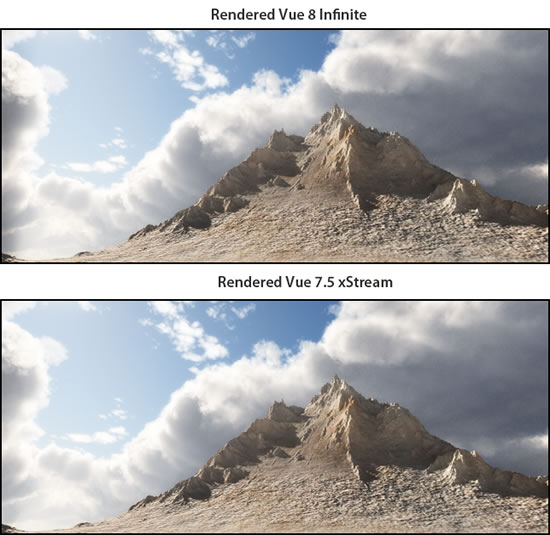
The following images are courtesy of Dax Pandhi from http://nukeation.deviantart.com/. Check out some of his other images using Vue 8. They demonstrate the powers of Spectral 3 Atmosphere.
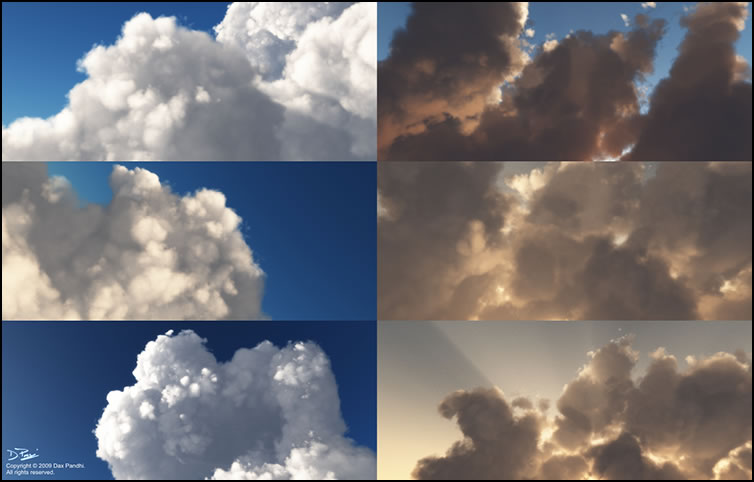
Materials
A number of the new features to Materials have been discussed elsewhere. Displacement has not been discussed and, in addition, a number of new features have been added to Vue 8 Infinite.
- Separate Bump and Displacement channels in the Function Editor
Below are examples of changes to the Material Editor as it deals with Displacement.
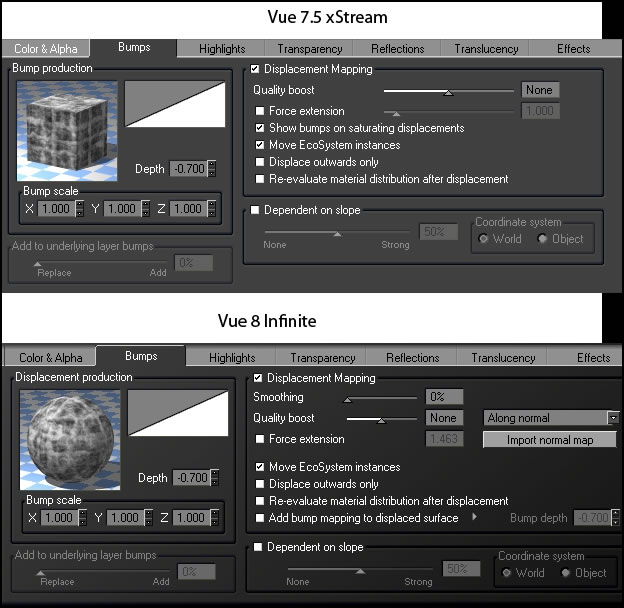
Below are examples of changes to the Function Editor as it deals with Displacement. Notice the new Displacement channel.
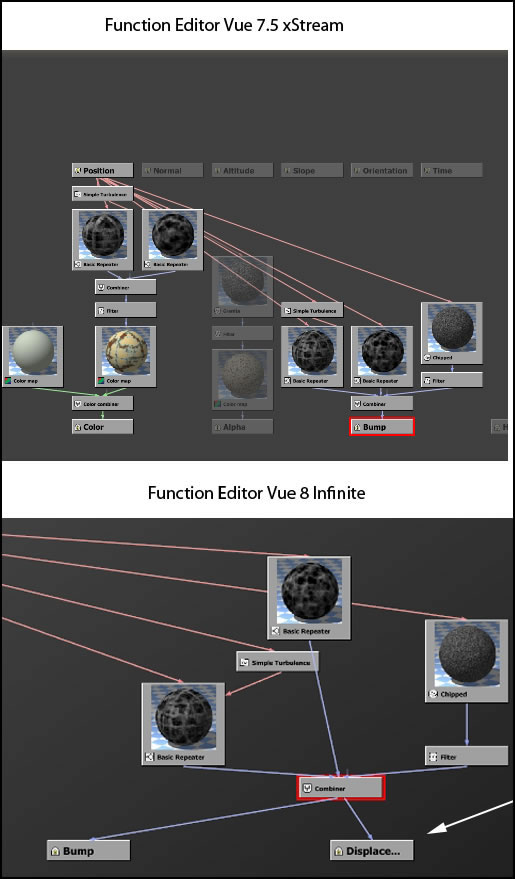
Also, there is:
- Cloned displacement
- Displacement in any direction
The displacement in the images below are exaggerated to show the differences..
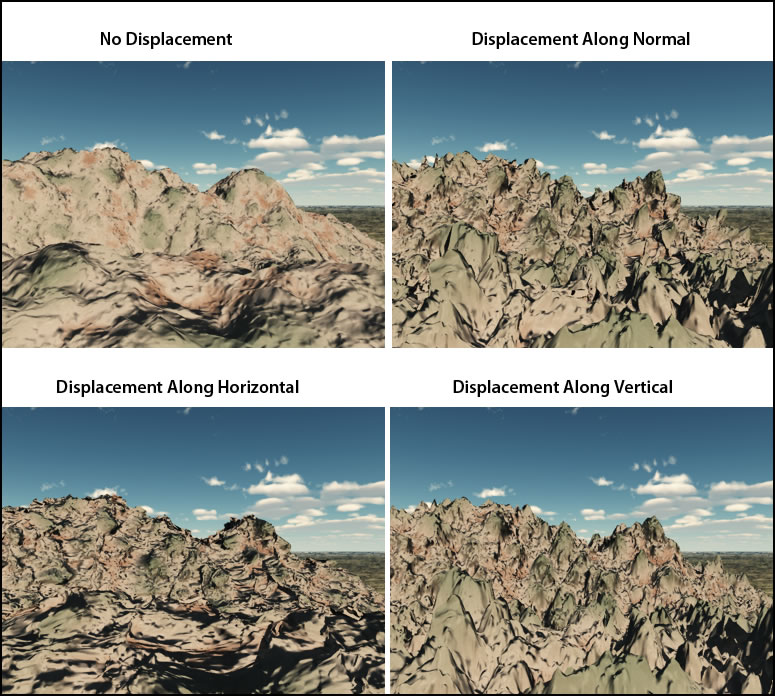
And there is also:
- Normal mapping
- Displacement smoothing to remove high frequency artifacts
Vegetation
Some new species have been added since version 7.5. Now there are over 170 species.
Mesh Rigging and Animation
Vue 8 Infinite has new support for working with rigged meshes:
- Direct re-posing of rigged meshes.
- Support for mesh morphs.
- Select and manipulate bones directly in views.
- Manipulate bones numerically using the Skeleton editor.
- Support for wired helpers.
- Highly optimized mesh skinning for fast refresh during animation scrubbing.
- Create custom rigged animations.
These features are not only useful for still poses but in creating animations, also.
Below is an example of the Skeleton Editor. I use Dave, a character from Vue Content. When I double-clicked on him, the Skeleton editor appeared, and I could manipulate him. This information will also appear in the World Browser.
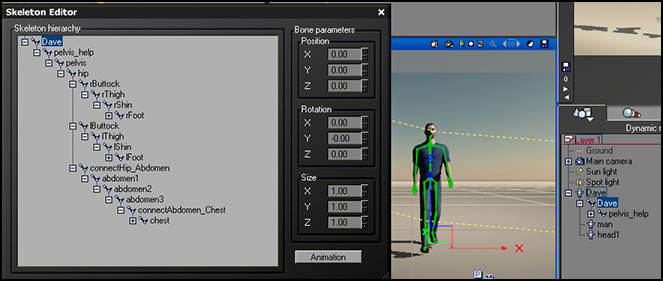
New Import/Export
- Support for rigged Collada meshes.
- Support for Sketchup 7 (Win 32 only)
- Support for Poser 8.
I decided to do a test comparing two OpenGL settings in Vue 8 Infinite and the OpenGL Hardware Accelerated setting in Vue 7.5 xStream. The results were very close together. I used a User setting and rendered a file size of 1600 x 1200. I chose two separate post rendering settings for film. While the different Open GL settings do not effect render times since they are preview related, they do effect memory usage.
When you look at the full size images, you will notice that the depth of color and slight variations are greater in Vue 8 than they are in Vue 7.5. One cannot tell from the size of the images here.
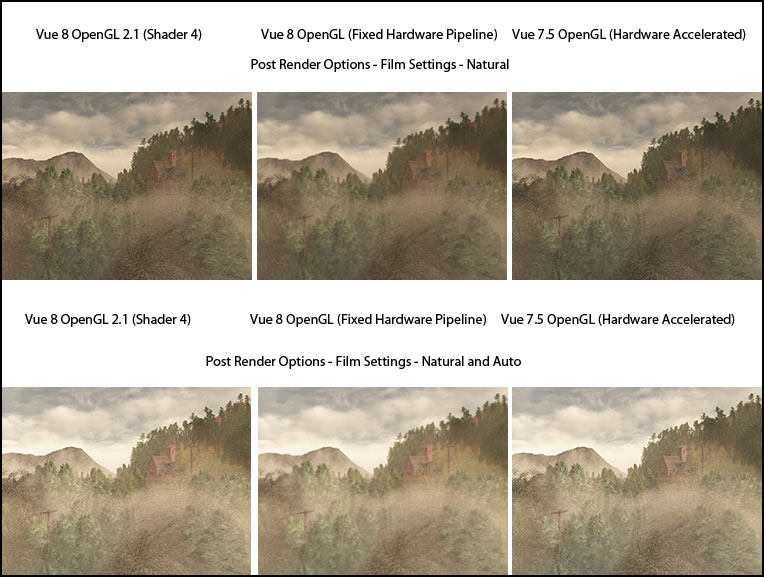
Below are listed memory at start of render and at finish and times.
| Vue 8 OpenGL 2.1 (Shader 4) | Vue 8 OpenGL (Fixed Hardware Pipeline) | Vue 7.5 OpenGL (Hardware Accelerated) | |
|---|---|---|---|
| Starting Memory | 85% | 90% | 90% |
| Ending Memory | 83% | 88% | 88% |
| Time for Render | 3 hrs, 35 mins, 37 secs | 3 hrs 35 mins 04 secs | 3 hrs 25 mins 33 secs |
Vue 8 uses new generations of EcoSystems (EcoSystem™ Generation III), SolidGrowth (SolidGrowth™ 4), and Spectral Atmospheres (Spectral 3 Atmosphere Model.)
The following requirements are from the e-on software website:
Minimum System Requirements
Macintosh- Mac OS X v10.4 up to 10.6,
- 2GHz Intel processor or faster,
- 1GB of free RAM,
- 200 MB of free Hard Disk space,
- 1024x768 in 65K colors/16 bits (24+ bits recommended).
- Windows XP/Vista/Windows 7 32/64,
- 2GHz Pentium IV or better processor,
- 1GB of free RAM,
- 200 MB of free Hard Disk space,
- 1024x768 in 65K colors/16 bits (24+ bits recommended).
Recommended System Specs
- Windows 64 bit (XP, Vista or Windows 7), Mac OS X v10.6
- Multi-core CPU (Intel QuadCore, Core I7, or Mac Pro),
- 4GB+ of RAM,
- 4GB+ of free Hard Disk space (on the drive hosting the OS),
- An OpenGL accelerated video board (see below for optimal compatibility)
Supported Video Boards
The following boards will perform using the new Shader engine. Other boards may not perform using the Shader engine, but will perform using the older fixed-pipeline one. In any case, Vue can perform in software OpenGL regardless of the video boards.
Windows:
- All boards with NVIDIA Quadro, GeForce8/9 and GT200 chips,
- ATI FirePro V8000 series with up-to-date drivers (i.e. not on original CD)
Boards with ATI Radeon 4800 series with updated drivers will work, but can suffer small performance issues. New ATI 5800 series remain untested at this point.
Macintosh:
- All boards with NVIDIA GeForce and GT200 chips,
- All boards with ATI Radeon HD and 4800 series (10.5.6+ required).
Boards that are not on this list may work with Vue, but haven't been extensively tested. If you run into any OpenGL issues, try disabling background draw and Anti-Aliasing in the Options panel. Worst case scenario: you can always run Vue in software OpenGL mode.
Recommended chips:
- NVIDIA GT260/275/280.
- NVIDIA QuadroFX 1800/3800 (5800 untested but should work fast and stable).
- ATI FirePro V8000 series with up-to-date drivers (i.e. not on original CD).
Macintosh:
- NVIDIA GT series.
- ATI HD 2600 and 4000 series.
Windows:
Not recommended:
- All ATI Radeon prior to 4000 series.
- ATI 9000 series, X series, and HD series might work, but with fewer options, and you may experience severe slowdowns.
- ATI FireGL 5000 series.
Macintosh:
- Intel-based GPU's and NVIDIA 7300 board will not work with Vue (with hw acceleration).
Windows:
Below are different full version prices. For upgrade prices, click on link since there are so many different ways to purchase Vue 8 Infinite.
Vue 8 Infinite - DVD Case |
|||||
Vue 8 Infinite - DVD Case + Standard Maintenance |
|||||
Vue 8 Infinite - DVD Case + Premium Maintenance |
|||||
Vue 8 Infinite - Download |
 
|
When I do a review such as Vue where there are good and active forums, I usually test the issues that are causing individual's problems and try to evaluate them in terms of writing a review. If I can duplicate them, they go into the review. If not, or I personally, don't think they are significant, I do not discuss them. Of course, if I encouter problems repeatedly while working with the program, I will include them in the review. As I have observed in the past, the same situation can cause some people problems while others don't have them. I had a few problems with this version of Vue. I created a number of still scenes trying to utilize as many of the new and old functions as possible. The issues I found I will discuss in the next few paragraphs.
If you download from Cornucopia3d, you should read the store FAQ. You can reload for different versions of Vue as well as have your download number reset if necessary. For some reason I never had problems using content when I changed versions (full installs) previously. I knew that there could be issues with license-locked downloads, but I had not experienced the problems. But I had problems with other items that were not license-locked. There are postings in the Renderosity forum, that state that e-on is planning a patch to allow better backward compatibility. (At the time of this review, November 2009, there was no patch available.)
Even when I reloaded some downloads, I still had some that would only work in Vue 7.5 even though they were stated as working in Vue 8. I encountered this with a few EcoSystems and Atmospheres. When I reported this to tech support, they told me they were aware of the problem.
The only other issues I had were some intermittent crashing and slowdowns. However, the crashes did not happen very often. They occurred mainly in two areas: sometimes when I moved plants or tried to work in the Plant Editor, the program would end. I finally saved the scene before trying to modify the plant. Also, occasionally in dealing with very large EcoSystems the machine slowed down or did crash or refused to load the EcoSystem and stopped working.
I do like this version of Vue even with the problems that I have mentioned. Many of the new features are great and allow the user to create a lot more than he could in previous versions. I find that the new additions such as the ability to sculpt terrains fantastic. I, also, like some of the non-played up parts such as the ability to see MetaClouds, etc. I really like the new OpenGL 2.1 (shader4). It makes visualizing scenes so much easier. Since I have that ability on one machine and not on the other, I can really see the difference. Other features such as the Strata filter in the Function Editor, the addition of more controls for displacement are also really good. I generally found this version to be more user friendly for some of the reasons above.
To see a review on Vue 7.5 xStream, click on the link. For information on e-on and its products, go to http://www.e-onsoftware.com. Also for more product information on Vue 8 Infinite, click on the link.
I want to add some links to these wonderful tutorials by Dax Pandhi, the founder of QuadSpinner. If you go to his website, you will see other Training Videos that he has created. I am in the process of reviewing his first two which are not listed here.
- Mighty Hyper Terrains If you have never used Metablobs or have never used them for creating rock formations, this tutorial is a must.
- The Beauty of Strata This excellent tutorial covers the new Recursive Filters-Strata and Confined Strata. This will show you the many ways to use it.